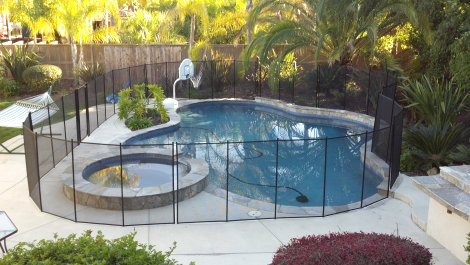

Pool Fencing Helps Prevent Drownings
Pool Safety
- Keep track of your children.
- If they are missing, check the pool first, down to the bottom.
- Learn CPR, you may be their only chance.
- And, of course, install a Viking Pool Fence.

Thank you to the Phoenix Children's Hospital web site, where we found 'The Myths of Drowning'. It's one of the better pieces we've seen about pool safety:
The Myths of Drowning
1. Most kids drown when their parents leave them poolside to answer the phone or the door.
Dozens of public service announcements and news spots have revolved around this scenario. It's familiar and easy to reenact. "I'll be right back, honey. You stay out of the pool," says the mother, as she runs for the phone. However, most drownings do not take place under circumstances such as these. According to clinical data collected at hundreds of drownings, we've seen that, in many cases, the child was not expected to even be in the pool area, or even outdoors. A far more common scenario is when a child who was thought to be indoors gains entry to the pool without the caregiver's knowledge.
A very compelling statistic from the Arizona Department of Health Services shows us how rarely a parent knowingly leaves a child by the pool. In 2001, the most recent year for the annual DHS report to be available, only 34 percent of children who experienced a life-threatening water-related incident were wearing swimwear. From this fact, we can infer that most of the children were not expected in or around the pool area at the time of the incident. Our own observations of the circumstances of drownings in the Valley has reinforced our belief that this scenario is not the norm, and that we need to alter our messages to parents accordingly.
2. Sure, we have lots of drownings, but it's not really a top cause of death. We lose more kids to other things, like fires and car wrecks.
In fact, in 2001, drowning caused as many unintentional, injury-related deaths as both motor vehicle accidents and fire and flames. Since the start of 2000, as of the date of this report, 892 children have drowned in Maricopa County. Arizona has a young population, a high rate of swimming pools, and largely in part because of that combination, one of the highest child drowning rates in the country.
3. Because of our latest public safety programs and messages, the drowning rate in the Valley is decreasing.
Actually, the rate overall is fairly static. In 1988 and 1989, there was a dramatic drop in the rate, when the first community-wide water safety programs began, and local barrier ordinances were enacted. Since that time, the rate has remained fairly steady.
Research tells us two facts: 1) that we know that the rate can be affected by effort from the community, and 2) our efforts since 1990 have not successfully brought about the same kind of change.
4. There is a new miracle class that can make kids safe around the water.
In the last 10 to 20 years, the number of choices for parents in swim classes has increased dramatically. Some parents assume that these classes can make their children safe around the water, and that can be is a fatal assumption. The American Academy of Pediatrics (AAP) states that, generally, children are not developmentally ready for swimming lessons until after their fourth birthday. Aquatic programs for infants and toddlers have not been shown to decrease the risk of drowning, and parents should not feel secure that their child is safe in water or safe from drowning after participating in such programs. Young children should receive constant, close supervision by an adult while in and around water.
It is tempting, when covering the issue of water safety, to merely show a child in the water with a qualified teacher and to omit the AAP's statement. But to pass over the position of the foremost authority on children's health, the American Academy of Pediatrics, leaves the public with an incomplete and dangerous belief.
What do we tell parents about swim lessons? As you will see later in the report, we suggest that swim lessons for children, at the appropriate age, are a critical part of an effective water safety plan like the ABC's of Water Safety. Regardless of a child's skill level, the level of supervision should remain high at all times around water.
5. There is a new miracle drug that can cure children who've been in the water too long.
Approximately 50 percent of children and adolescents requiring physician care for a submersion incident will die. This mortality is enormously higher than any other injury problem, with the exception of self-inflicted gunshot wounds.
One significant outcome is often left out altogether from the news reports: the near-drowning. In one third of the cases where a child is comatose upon admission to the ED and survives, that child will suffer significant neurological damage. This heartbreaking outcome should not be forgotten, because it is a compelling consequence that might inspire many parents to take steps to prevent injury to their own child.
6. There is a new miracle product that can prevent drownings.
Only one single device has ever been tested, researched, and proven to have an effect upon drownings, and it's been around for decades: a four-sided, isolation type pool fence, made from wrought-iron or approved vinyl material. A four-sided, isolation-type fence does not attach to a structure or a block wall, and should include a self-closing, self-latching mechanism and a child-proof lock.
The reason that a four-sided pool fence is so successful in preventing drownings is that it provides a barrier between children and the water, effectively separating the pool from the home. This strategy of placing barriers, or layers of protection, is an extremely valuable effort, and is endorsed by the experts in the field of injury prevention, such as the Centers for Disease Control, the American Academy of Pediatrics, the Red Cross, and the Consumer Product Safety Commission.
Alarms, door latching devices, nets, and covers have not been tested in the same manner as pool fences, and therefore we presently do not have evidence showing their effectiveness. These devices may be used as are valuable additions to a sound, four-sided pool fence meeting local code, but should never act as substitutes.
You will notice that we do not include study data for products like flotation toys and suits, mesh fences, and pool nets. (Study data for fences is included in the next section.) A search of the major journals most closely related to this issue did not have any studies related to these products. That does not mean they are ineffective or dangerous, but they have not been tested and researched in the same manner as isolation fencing. Parents should be encouraged to rely first upon the most solid and trusted product, then to discuss additional products and their place in a water safety plan with their pediatrician. Most importantly, parents and caregivers should know the difference between toys and lifesaving devices.
7. Fences don't make a difference - kids can climb them, and kids drown even when fences are used properly.
Several compelling studies discuss pool fences and their effectiveness. Here's a rundown of the findings:
The Arizona Child Fatality Review program studied 198 drownings between 1995-1999 and found that
81 occurred in a private pool. Of those, they found only four deaths that occurred in backyard pools where there was an adequate pool
fence that had a properly functioning, locked gate.
A study done at the Royal Children's Hospital in Australia found that, of the
33 drownings they examined, over half of the homes did not have any fence, and of those that did, only three met government standards.
In not one case did a child gain unaided access to a pool fitted with a fully functional gate and fence that met the Australian standard.
A University of Western Australia study found that 68 percent of drownings occurred in pools that did not have a four-sided fence,
with an almost two-fold increased risk of a childís drowning in a swimming pool with three-sided versus four-sided fencing.
Drownings
do occur in homes that have pool fences. However, in all of these cases, the fence was not in proper working order at the time of
the drowning. A pool fence cannot prevent drownings when it falls into disrepair, is left unlocked or propped open, or when children
are able to climb over or under the fence, by way of trees or yard furniture on the exterior of the fence.
Discussion about barriers is the critical ingredient most commonly left out of local campaigns and reports. Including information about barriers is the single most effective means that media professionals can use to reduce drownings. This is because a significant portion of the population in Arizona does not have barriers around pools, a fact we can infer from looking at countries and states with similar swimming pool ownership rates and legislation:
A New Zealand study examining compliance with that countryís stringent pool fence legislation showed
that only 44 percent of pool owners complied with the legislation.
A University of Queensland, Australia study showed that pool owners,
with or without children, were less likely to perceive having a childproof fence as being important.
A University of California, Davis
study found that only 35 percent of respondents who endorsed a complete barrier requirement for all pools had a fence surrounding
their own pool.
8. Kids only drown in pools, and only in the summer.
We do see a spike in drownings in the summer, but a significant number of children drown in the winter months.
Additionally, children drown in numerous locations other than pools. A small child can drown in as little as a single inch of water, which makes for a tremendous number of hazards in the average home. Educating parents about these additional hazards can be a lifesaving effort.
9. People just don't listen -- to either media or safety professionals. There is nothing we can do to prevent drownings.
As shown by the dip in drownings in the early 1990s, we know that the Maricopa County drowning rate can be decreased. Additional studies also confirm the fact that efforts to educate and prevent drownings are not a waste of time:
A University of Washington study addressed parents who were given prevention information, including life vest information,
with their Emergency Department discharge instructions. Later, 50 percent recalled receiving the information, 41 percent recalled
the message specifically, and 35 percent who did not own a life vest stated they would subsequently consider buying a life vest.
A
San Diego University study showed that an injury prevention program used with children in first through third grades showed a significant
increase in knowledge about injuries and safe behaviors, and a decrease in self-reported, high-risk behaviors.
10. If we encourage
supervision alone, just tell the public often enough, and forcefully enough, to watch their kids around water, we've done enough to
we can stop drownings.
The intention of this report is not meant to decrease the supervision message, coverage or discussion of water safety, nor to criticize previous messages and campaigns. The point of this report is to show that we can empower the public and address this crisis have an effect on the drowning rate if we say the right things. Telling parents to watch children around water is an important first step. However, given what we know about typical drowning scenarios, risky behaviors by parents and children, and unfenced pools in the Valley, we must take the next step and shatter the myths that have become accepted as facts, both among the media and the public.
